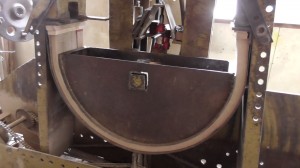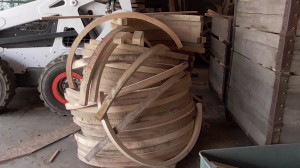After a day’s travelling from Colonial Williamsburg, Virginia to Pittsburg, Pennsylvania I settled in to the hotel for the night. the sheer distances I will be covering between stops will be tiring but if there’s anything out there as inspirational as what I have experienced so far then it will be worth the effort. On the morning of day eleven I was met by Blacksmith Jymm Hoffman who had kindly offered to be my host for the day. Jymm contacted me through social media after hearing about the project and offered to take me to visit an Amish wheelwright he has used in the past. I jumped at the opportunity to visit an Amish Wheelwrights shop, this is not only a rare insight into an interesting community but the chance to see a Workshop that could be quite alien to anything I have seen before. The journey to the Wheelwrights shop over the border into Ohio was a great chance to chat with Jymm about life and work in general, it sounds like he gets some really interesting commissions. Jymm is an avid historian and much of his work is for museums and reenactment groups, it was interesting to gain an insight into his business as I do work along the same lines in the UK. As we neared the Amish shop it was fascinating to see the grooves warn into the roads by continous horses hooves trotting here and there with the typical buggies in tow. Everyone we passed on the road took the time to wave at us in politeness, the area was well maintained and clean, this looks a heavenly place to me.
Upon arrival at the shop we were greeted by Melvin Stutzman, he was good enough to direct us straight into his workshops and to conduct a tour. Immediately my mind was blown just by the amount of buggy wheels stacked outside the building awaiting repairs. Then there was the workshops, the metal shop was very tidy, the various metal sections neatly racked up in place and the bulk of the area kept clean (maybe it’s about time I made my shop a little more organised). The biggest thing to catch my eye as we entered the building was the massive tyre setter taking up a sizeable area of the shop. A tyre setting machine is used instead of heating the tyres to get them on the wheels. The method I use back home is to make the tyre smaller than the wheel in circumference then heat it in a fire so it expands then put it over the wheel and cool/shrink it quickly with water. The setting machine eliminates the need for this process as you simply make the tyre fit over the wheel and the machine crushes the tyre onto the wood using pneumatic rams.
Once the Wheelwrighting chat was in full flow Melvin showed me his Felloe bending machine, this in my opinion was an absolute masterpiece of home built machinery. The Stutzman’s had built this bending machine from scratch in their own shop and it was brilliant! As anyone who has steam bent timber will know it’s not that straight forward, especially when achieving curves as tight as the ones encountered on some of these wheels. 

The Stutzmans had a machine for every task, in fact it soon became apparent that this is probably the most advanced wheelwrights shop I have ever been in. There was good reason for this, it turns out they can handle up to as many as 200 wheels in a couple of weeks! I would be doing well to produce or repair that many in a year. Some of the work they encounter includes everything from wooden car wheels to bicycle wheels, buggy wheels and alike, they even had some rather large chandelier wheels in ready for collection.
It was great to experience the Stuzman’s shop, an opportunity I am glad to have taken. The sad truth is I expected them to be very old fashioned and maybe even behind the times (if that term fits?) but in fact they are more than equipped to make or manufacture wheels in a big way.
On the way back to the hotel Jymm, my excellent tour guide and host offered to take me to his workshop to see the setup he uses. Another opportunity not to be missed! Wheelwrighting in traditional village life goes hand in hand with Blacksmithing, there generally can’t be one without the other. In ‘modern’ Wheelwrighting the tendency is to do all aspects in house so anything you can learn about either side of the trade is a bonus.
Jymm has an interesting shop based out of an old factory, his workshop is nestled in this interesting site, surrounded by big industrial buildings. He has an interesting modern setup (especially compared to Colonial Williamsburgs smithy) equipped with power hammers and gas forges.
After a tour of the workshop Jymm fired up a forge and offered to demonstrate how he makes strake nails like the ones I had used with the Colonial Williamsburg Wheelwrights a few days earlier. Watching him make the nail in only a single heat was awesome, the speed and accuracy with which he used the power hammer was a testament to his experience. It had been many years since I had used a power hammer, these beasty machines are the big boys toys of many blacksmiths dreams. Obviously when Jymm handed me an apron and said “now you have a go” I was extremely apprehensive! but also very excited. After a slow tentative start on the machine I manage to draw out a nail (and what a nail it was)… Then came the next challenge, whilst chatting in the car I had mentioned my lack of experience at fire welding, Jymm had obviously taken note as the next demo was chain making! First of all Jymm made up a couple of chain links. It was then up to me, it was nice to have the tuition of an expert. If anything I found the welding work far easier than I had hyped it up to be, the welds were all neat and tidy.
At the end of such an exciting day we celebrated with an ice cold beer in a local bar (well earned in the heat of the smithy). The chain and nail are safely stowed in my suitcase, ready for exhibition when I return home. Next stop Kentucky……









